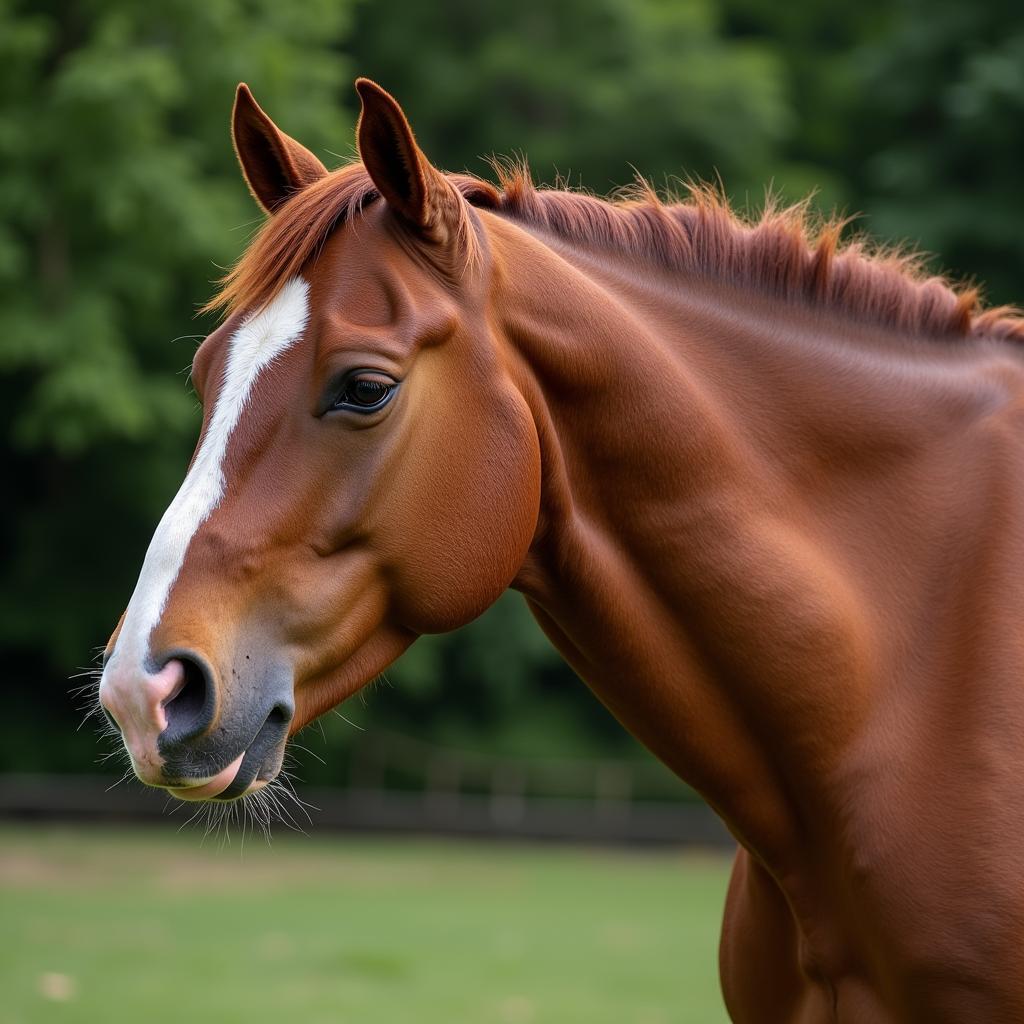The Horse Trapezius Muscle plays a crucial role in the horse’s movement, posture, and overall well-being. Understanding its function and potential problems is essential for any horse owner or enthusiast. This article will delve into the anatomy, function, and common issues associated with the horse trapezius muscle, providing you with valuable insights to help you care for your equine companion.
Anatomy and Function of the Horse Trapezius
The trapezius muscle in horses is a large, superficial muscle located in the neck and shoulder region. It’s divided into two parts: the cervical (neck) and thoracic (chest) portions. The cervical part originates from the nuchal ligament and the cervical vertebrae, while the thoracic part arises from the supraspinous ligament of the thoracic vertebrae. Both parts insert on the spine of the scapula (shoulder blade).
The primary function of the trapezius muscle is to elevate and rotate the scapula. This action is vital for proper shoulder movement and stride length. The trapezius also helps to stabilize the shoulder joint and contributes to the horse’s overall posture. When the horse raises its head, the cervical portion of the trapezius aids in this movement. The thoracic portion helps to swing the foreleg forward during locomotion. A well-conditioned trapezius muscle is crucial for athletic performance and prevents injuries.
Have you ever wondered what causes a horse to tie up? what causes a horse to tie up
Common Problems Affecting the Horse Trapezius Muscle
Several issues can affect the horse trapezius muscle, ranging from minor strains to more serious injuries. These can result from trauma, overuse, poor saddle fit, or underlying musculoskeletal problems.
- Muscle Strain: This is a common injury, often caused by overexertion or improper warm-up. Symptoms include stiffness, soreness, and reluctance to move the neck or shoulder.
- Atrophy: Disuse or nerve damage can lead to muscle atrophy, where the trapezius muscle shrinks and weakens. This can result in a noticeable dip in the shoulder area.
- Myositis: Inflammation of the muscle tissue (myositis) can be caused by infection, trauma, or autoimmune disorders. Symptoms include pain, swelling, and heat in the affected area.
- Trauma: Direct trauma, such as a fall or collision, can cause bruising, tearing, or even rupture of the trapezius muscle.
A horse with a trapezius muscle problem may exhibit signs of lameness, stiffness, and difficulty moving the neck or shoulder. Early diagnosis and treatment are essential to prevent long-term complications. For instance, a poorly fitted saddle can cause significant discomfort and strain on the trapezius, eventually leading to more severe issues like muscle atrophy or even a tooth abscess. Learn more about tooth abscesses in horses here: tooth abscess horse
Maintaining a Healthy Horse Trapezius Muscle
Maintaining a healthy trapezius muscle is key to ensuring your horse’s overall health and performance. Here are some essential tips:
- Proper Conditioning: Regular exercise and a balanced training program help to strengthen and condition the trapezius muscle.
- Warm-up and Cool-down: Always warm up your horse before exercise and cool down afterward to prevent muscle strain and injury.
- Correct Saddle Fit: A properly fitted saddle distributes weight evenly and minimizes pressure points, preventing strain on the trapezius and other muscles. An improperly fitted saddle can even contribute to dental issues like a tooth root abscess. More information on this can be found at tooth root abscess horse.
- Regular Veterinary Checkups: Routine veterinary examinations can help identify and address any potential muscle problems early on.
- Proper Nutrition: A balanced diet provides the necessary nutrients for muscle health and repair.
Quote from Dr. Emily Carter, DVM, Equine Sports Medicine Specialist: “Proper conditioning and saddle fit are paramount in preventing trapezius muscle injuries. Regular veterinary checkups can detect subtle changes before they become major issues.”
What are the symptoms of a strained horse trapezius muscle?
A strained horse trapezius muscle often presents as stiffness, soreness, and a reluctance to move the neck or shoulder.
 Healthy Horse Trapezius Muscle
Healthy Horse Trapezius Muscle
Conclusion
The horse trapezius muscle plays a vital role in movement, posture, and overall health. Understanding its anatomy, function, and common issues can help horse owners provide optimal care and prevent potential problems. By prioritizing proper conditioning, warm-up, saddle fit, and regular veterinary checkups, you can ensure the health and well-being of your equine companion’s trapezius muscle for years to come. Don’t hesitate to contact a veterinarian if you suspect your horse has a trapezius muscle issue. A dental speculum might be necessary to check for dental issues that could be causing discomfort. Find out more about dental speculums for horses: dental speculum horse.
FAQ
- What is the horse trapezius muscle?
- What are the functions of the horse trapezius muscle?
- What are the common problems associated with the horse trapezius muscle?
- How can I prevent trapezius muscle injuries in my horse?
- What are the signs of a trapezius muscle injury?
- How is a trapezius muscle injury diagnosed?
- What are the treatment options for a trapezius muscle injury?
Need more information on horse health? You might find our articles on horse tooth abscess pictures helpful: horse tooth abscess pictures.
Contact us: Phone: 0772127271, Email: [email protected] or visit us at QGM2+WX2, Vị Trung, Vị Thuỷ, Hậu Giang, Việt Nam. Our customer service team is available 24/7.